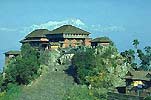 |
|
|
| Nepal - History |
|
 |
| Nepal's History Time Line |
| 18st Century |
|
|
| 19st Century |
1816: Nepal becomes quasi-British protectorate after Anglo-Nepali war.
1846: Nepal falls under sway of hereditary chief ministers known as Ranas, who dominate the monarchy and cut off country from outside world.
| 20st Century |
1923: Britain formally recognises Nepal's independence though foreign relations remain under British control.
1950: Anti-Rana forces based in India form alliance with monarch.
1951: Sovereignty of crown restored and anti-Rana rebels in Nepalese Congress Party form government.
1959: Multi-party constitution adopted.
1960: King Mahendra seizes control and suspends parliament and party politics after Nepali Congress Party (NCP) wins elections.
1962: New constitution provides for non-party system of councils known as "panchayat" under which king exercises sole power.
1972: King Mahendra dies, succeeded by Birendra.
1980: Constitutional referendum follows agitation for reform. Small majority favours keeping existing panchayat system. King agrees to allow direct elections to national assembly - but on a non-party basis.
1985: NCP begins civil disobedience campaign for restoration of multi-party system.
1986: New elections boycotted by NCP.
1989: Trade and transit dispute with India leads to border blockade by Delhi resulting in worsening economic situation.
1990: Pro-democracy agitation co-ordinated by NCP and leftist groups. Street protests suppressed by security forces resulting in deaths and mass arrests. King Birendra eventually bows to pressure and agrees to new democratic constitution.
1991: Nepali Congress Party wins first democratic elections. Girija Prasad Koirala becomes prime minister.
1994: Koirala's government defeated in no-confidence motion. New elections lead to formation of Communist government.
1995: Communist government dissolved. Radical leftist group, the Nepal Communist Party (Maoist) begins insurrection in rural areas aimed at abolishing monarch and establishing people's republic.
1997: Continuing political instability as Prime Minister Sher Bahadur Deuba is defeated and replaced by Lokendra Bahadur Chand. Chand is then forced to resign because of party splits and is replaced by Surya Bahadur Thapa.
1998: Thapa stands down because of party splits. GP Koirala returns as prime minister heading a coalition government.
1999: Fresh elections give majority to Nepali Congress Party. Krishna Prasad
Bhattarai becomes prime minister.
 |
